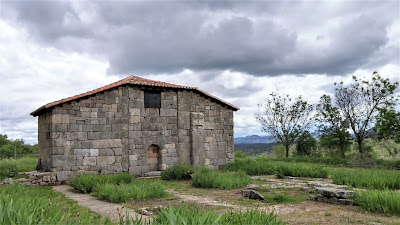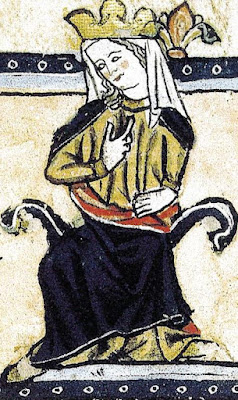 |
Santa Maria de Lara and the rocky outcrop I tried to evoke in Seven Noble Knights
All photos in this post 2018 Jessica Knauss unless otherwise specified |
In the wild green rolling lands of Lara, southeast of Burgos, a lone traveler may come upon Santa Maria de Lara and feel as if she's discovering it for the first time. This Visigothic temple has been set against a dramatic rocky backdrop that now gives the region its name for more than 1300 years.
 |
Quintanilla de las Viñas seen from Santa Maria de Lara.
Most writers discussing the church use the town's name to refer to the temple. |
I first discovered this rare evidence of Visigothic activity in 2015 during my second adventure in Spain with my beloved, now departed, husband. We were on our way to see
Salas de los Infantes and other
Seven Noble Knights locations for the first time, so when I saw the diminutive pink sign on the highway that indicated "Visigothic temple, seventh century" this way, we didn't feel we could spare the time that morning.
 |
Santa Maria de Lara with the Castle of Lara de los Infantes behind
Photo 2015 Jessica Knauss |
Returning to Burgos after the day's rainy adventures, we drove past a patch of fossilized sauropod tracks and the village of Quintanilla de las Viñas and got the full impact of where the temple sits. The barest indications of civilization, Lara Rock looming with its fascinating caves, and the evocative ruins of the Castle of Lara de los Infantes (where the first Count of Castile was born, I found out later!) off in the distance set the weight of the centuries firmly upon these stones.
It was closed. I mean really closed, as if we were the first people to whom it had occurred to go inside. There was an informative sign with photos of the interior, but no indication that it ever opened. I would have to live through many more experiences over the following three years before this site divulged its secrets to me.
This year, after delving into the fascinating story and fantastic art of
San Pedro de la Nave, I was raving to return to Quintanilla de las Viñas to see the inside and slipped it into an epic journey this summer with my adventurous-for-history mother.
When you come upon the site from town, it's not impressive. The wall that faces you is unadorned and has a bricked-up door. It turns out that even this unsightliness tells us an important part of Quintanilla's story. When it was first built, near the end of Egica's reign, and for a few hundred years thereafter, the church was decorated all around and occupied three times the space it does now. In the ninth or tenth century, a major restoration project was undertaken. Some time after it was donated to the monastery at San Pedro de Arlanza in 1038, Quintanilla entered a long, slow period of decline, and two thirds of the structure caved in and/or was harvested for the stones to be used in other buildings long since vanished.

The space at the front of the building when you approach from the village marks out the temple's original footprint, which was defined during archaeological digs at the site. The wall that greets visitors today was not in the original plans at all. Only a little more than the apse of the original structure now survives. It's when you come around the side that you get a sense that this is more than a hasty pile of rocks.
 |
| Photo 2015 Stanley Coombs |
I remember coming around to "the back" in 2015 and being mystified by the multitude of friezes. Now I would recognize these abstruse symbols even out of context as the themes of the most richly decorated exterior of a Visigothic building in all of Spain. Notice also the crosses scratched repeatedly into the less decorated stones. This year, I was able to verify that these are medieval graffiti.
 |
| Photo 2018 Kay Holt (my lovely mum!) |
This time, as we approached the open door (visible on the left here), a man popped out of the ranger building (also on the left here). We exchanged greetings and he ended by saying he would be with us momentarily.
My mother and I explored for a few minutes by ourselves, and when a Spanish couple arrived, the ranger came back out to give us his grand tour. The elegant vines (Are these the
viñas in the town's name?), grape bunches, palm leaves, and birds recall
San Pedro de la Nave and have much the same symbolic interpretations attached to them. The birds are the human soul, the palms represent divinity, and the vines and grapes represent the sacramental blood of Christ that gives life to the soul-birds. I've seen similar patterns on modern buildings in Zamora. They may be trying to evoke a time long past, but they mainly imitate these friezes because they're so lovely.
The pièce de resistance of the exterior is found in the middle frieze, behind the main altar, on the left. Among palm leaves, we find three sets of monograms, which scholars have read as FLNA, DNLA, and FCRN(T). These letters are likely the names of two individuals who gave the money to build or restore the church or the stonemasons themselves, variously interpreted as Flammola and Danila or Flainus and Dilanus, and the Latin
fecerunt, "made (this)."
I love a good building with a mysterious signature!
 |
| Photo 2018 Kay Holt |
Walking inside, it's obvious that the building is much smaller now than it was originally because it's hard to contemplate the glorious main archway without backing into the current wall. It's clearly seen better days, and you come to appreciate that the wall was necessary to prevent further deterioration. Even so, what's left takes away the breath of anyone who likes old stuff.
Above the arch, barely visible in the photo, rests what is likely the oldest Christ in Majesty in Spain. It, and all the reliefs in the church, have a strong Byzantine vibe that could have been imported to Spain any time between the sixth and tenth centuries, causing some scholars to doubt that the temple is in fact Visigothic.
This
snarky blog in Spanish offers a clearer photo of the Christ in Majesty (item 7) and also reveals that in 2004, two panels depicting probable evangelists were stolen from the site. All we saw of the panels this summer were these photos of them in a niche, so I assume their whereabouts are still unknown.
Update: The panels were found in a garden in north London on January 22, 2019 after a decade of art detective work! They'll be returned to Spain and likely put on display in the Museum of Burgos.
Yippee! The news from El diario de Burgos
The magnificent arch continues the signature vines-and-birds theme, but the unique part comes with the brackets under the arch, to the sides, resting on columns probably repurposed from a Roman site. With their symbolism and another signature, they tell tremendous stories about the people who built the temple, if only we knew how to read them.
On the left, clearly missing another angel, we have a portrait of a humanoid in a double circle wearing a crescent moon as if it were horns. On either side of its head, the Latin letters LUNA permit no doubt that this is a carryover from pre-Christian worship of celestial bodies. What is it doing in a Christian temple? Some scholars have looked at the frieze on the right bracket and deduced that the Moon here must represent the Virgin Mary or the Church (feminine Ecclesia). Many doubt this because the Moon clearly has a short, thoroughly unfeminine beard, in keeping with the Germanic origin of Moon worship. So its placement here remains a fascinating headscratcher.

The interpretations of the SOL (Sun) frieze on the right as Christ illuminating the world feels more likely. It has a similar problem, though. This Sun looks rather more feminine than we usually think of Jesus. Another shoulder shrug, for sure, even as we admire the strange wings and nimbuses of the angels framing the portrait.
This bracket is doubly wonderful because there was room at the top for a little medieval humility bragging. The letters translate to "Humble Flammola offers this modest gift to God." This gives credence to the "Flammola" reading of the exterior frieze. Many scholars believe this signature is from the ninth or tenth century, which puts me on
Seven Noble Knights alert. The name "Flammola" had morphed into "Lambra" by the thirteenth century, when the seven noble knights' legend was first written down.
Lambra, the name of the villainess of
Seven Noble Knights! As unusual at it seems today, this name was common in the early Middle Ages, so the Flammola/Lambra who founded or restored this extraordinary church was probably not also the scourge of the heroes in my book. In spite of how close this temple is to Salas and Barbadillo, where
the bloody cucumber incident set everything in motion...
Behind all this excitement, we find the area that would've housed the main altar and been the site of the most sacred and secret ceremonies. The wooden roof is completely modern, but it's hard to fathom the age of the stones in the floor.
This column and capital supporting the rudimentary altar is Roman in origin and was placed here in the twentieth century.
The most interesting pieces in the altar space provoke yet more questions. They're two friezes that may have served as brackets or column capitals in a no-longer-extant archway. They're similar in layout and style to the Sun and Moon friezes, and if possible, their subjects are even more puzzling. This one, on the left, appears to depict a male figure holding a cross. One angel frames the person and the other holds a smaller cross. All the figures have hair that could be mistaken for halos. The informative leaflet I purchased from the ranger at the end of the tour proposes that the central figure here could be the husband of the Flammola who donated the money to build the church. Essentially, that guess is as good as any.
 |
| Photo 2018 Kay Holt |
On the right, the same idea is carried out without the crosses. Could this be Flammola? Or are these Christ and the Virgin Mary? More evangelists? In my version of history, someone once wrote down the exact intentions of these bizarre pieces, and a lucky scholar (yours truly?) is destined to find that writing and resolve so many doubts once and for all.
On top of this frieze, the keepers of the site have placed models of the church as it is now and how it's thought to have started out. The contrast confronts the visitor with the ravages of time. When you realize how lucky we are to have even this much of the building to gaze upon, it's also an opportunity to make peace with not having all the answers.
The ranger kindly took our photo with the church and Lara Rock. It was almost laundry day, and my mother and I had ended up with only blue clothes to wear for this monumental visit. It was an honor to be at Quintanilla de las Viñas in such good company, both times.
A visitor in 2012 also had an enjoyable time.





























































